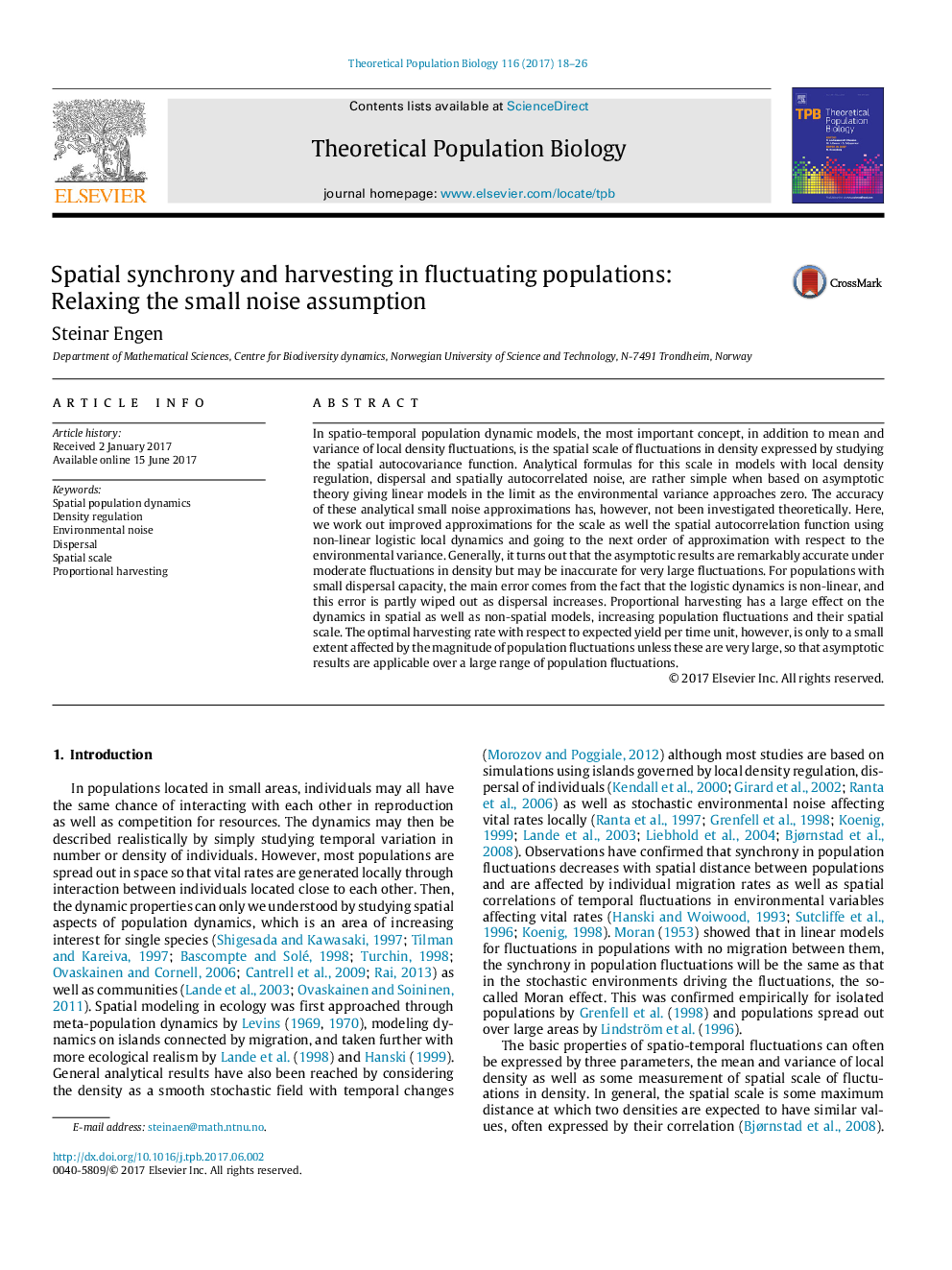| کد مقاله | کد نشریه | سال انتشار | مقاله انگلیسی | نسخه تمام متن |
|---|---|---|---|---|
| 5760599 | 1624136 | 2017 | 9 صفحه PDF | دانلود رایگان |
عنوان انگلیسی مقاله ISI
Spatial synchrony and harvesting in fluctuating populations:Relaxing the small noise assumption
ترجمه فارسی عنوان
هماهنگی فضایی و برداشت در جمعیت های نوسان: رعایت پیش فرض سر و صدا کوچک
دانلود مقاله + سفارش ترجمه
دانلود مقاله ISI انگلیسی
رایگان برای ایرانیان
کلمات کلیدی
دینامیک جمعیت فضایی، تنظیم چگالی سر و صدای محیطی، پراکندگی، مقیاس فضایی، برداشت منصفانه،
ترجمه چکیده
در مدل های دینامیکی جمعیت فضایی، مهمترین مفهوم، علاوه بر معیار و واریانس نوسانات چگالی محلی، مقیاس فضایی نوسانات تراکم بیان شده توسط مطالعه تابع اتوکوکاریابی فضایی است. فرمول های تحلیلی برای این مقیاس در مدل های با تنظیم مقیاس چگالی محلی، پراکندگی و سر و صدا مستقل مکانی، بسیار ساده است، زمانی که بر مبنای تئوری اختلاط دادن به ارائه مدل های خطی در حد، به عنوان واریانس محیطی صفر است. با این حال، دقت این تقریب نوری کوچک تحلیلی، به لحاظ نظری مورد بررسی قرار نگرفته است. در اینجا، ما تقریبهای پیشرفته برای مقیاس و نیز عملکرد تابع وابستگی فضایی را با استفاده از دینامیک محلی لجستیک غیر خطی و به منظور تقریب بعدی با توجه به واریانس زیست محیطی می پردازیم. به طور کلی، معلوم می شود که نتایج آستانه بر اساس نوسانات شدید در تراکم قابل ملاحظه ای دقیق است اما ممکن است برای نوسانات بسیار زیاد نادرست باشد. برای جمعیت با ظرفیت پراکندگی کوچک، خطا اصلی این است که دینامیک لجستیک غیر خطی است و این خطا تا حدی به دلیل افزایش پراکندگی کاهش می یابد. برداشت ضرایب تأثیر زیادی بر پویایی مدل های فضایی و غیر فضایی، افزایش نوسانات جمعیت و مقیاس فضایی آنها دارد. با این حال، میزان برداشت بهینه با توجه به عملکرد مورد انتظار در واحد زمان، تنها به اندازه کوچکی تحت تأثیر بزرگی نوسانات جمعیت قرار می گیرد، مگر اینکه این بسیار بزرگ باشد، به طوری که نتایج آستانه بر روی طیف وسیعی از نوسانات جمعیت قابل اجراست.
موضوعات مرتبط
علوم زیستی و بیوفناوری
علوم کشاورزی و بیولوژیک
علوم کشاورزی و بیولوژیک (عمومی)
چکیده انگلیسی
In spatio-temporal population dynamic models, the most important concept, in addition to mean and variance of local density fluctuations, is the spatial scale of fluctuations in density expressed by studying the spatial autocovariance function. Analytical formulas for this scale in models with local density regulation, dispersal and spatially autocorrelated noise, are rather simple when based on asymptotic theory giving linear models in the limit as the environmental variance approaches zero. The accuracy of these analytical small noise approximations has, however, not been investigated theoretically. Here, we work out improved approximations for the scale as well the spatial autocorrelation function using non-linear logistic local dynamics and going to the next order of approximation with respect to the environmental variance. Generally, it turns out that the asymptotic results are remarkably accurate under moderate fluctuations in density but may be inaccurate for very large fluctuations. For populations with small dispersal capacity, the main error comes from the fact that the logistic dynamics is non-linear, and this error is partly wiped out as dispersal increases. Proportional harvesting has a large effect on the dynamics in spatial as well as non-spatial models, increasing population fluctuations and their spatial scale. The optimal harvesting rate with respect to expected yield per time unit, however, is only to a small extent affected by the magnitude of population fluctuations unless these are very large, so that asymptotic results are applicable over a large range of population fluctuations.
ناشر
Database: Elsevier - ScienceDirect (ساینس دایرکت)
Journal: Theoretical Population Biology - Volume 116, August 2017, Pages 18-26
Journal: Theoretical Population Biology - Volume 116, August 2017, Pages 18-26
نویسندگان
Steinar Engen,
